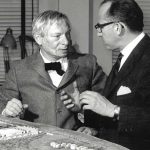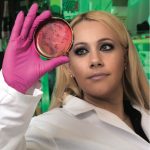When a receptor on the surface of a T cell—a sentry of the human immune system—senses a single particle from a harmful intruder, it immediately kicks the cell into action, launching a larger immune response. But exactly how the signal from a single receptor, among thousands on each T cell, can be amplified to affect a whole cell has puzzled immunologists for decades. Salk Associate Professor Björn Lillemeier, first author Zachary Katz and colleagues discovered the key to the amplification of an “invader” signal: the T cell receptor that detects the intruder turns into a mini-machine, activating and releasing copy after copy of a protein called ZAP70. The finding, published in Nature Immunology on November 21, 2016, could help scientists design better immune-mediated treatments for cancer or autoimmune diseases.
Read News ReleaseImmunology
Collaboration uncovers how molecular machines assemble
Ribosomes—macromolecular machines consisting of RNA and proteins that twist, fold and turn—are responsible for making all of the protein within a cell, but because they assemble so speedily, researchers haven’t been able to figure out how they come together. As part of a collaboration between Salk and The Scripps Research Institute, co-senior author Dmitry Lyumkis, a Helmsley-Salk Fellow, deployed a cutting-edge imaging method called single-particle cryo-electron microscopy (cryo-EM) and accompanying analysis tools to decipher some of the key steps for how ribosomes are assembled, a first step in understanding their roles in health and disease. The results appeared online December 1, 2016, in the journal Cell.
Read News ReleaseSalk scientists crack the structure of HIV machinery
Helmsley-Salk Fellow and senior author Dmitry Lyumkis, first author Dario Passos and collaborators have solved the atomic structure of a key piece of machinery that allows HIV to integrate into human host DNA and replicate in the body. The findings about this machinery, known as the “intasome,” appeared January 6, 2017, in Science and yield structural clues informing the development of new HIV drugs.
Read News ReleaseCurb your immune enthusiasm
Normally when we think of viruses, from the common cold to HIV, we want to boost people’s immunity to fight them. But for scientists who develop therapeutic viruses (to, for example, target cancer cells or correct gene deficiencies) a more important question is: How do we keep people’s natural immune responses at bay? In these cases, an overenthusiastic immune response actually undermines the therapy. Salk Associate Professor Axel Nimmerjahn and first author Yusuf Tufail—along with Associate Professor Clodagh O’Shea, Professor Greg Lemke and colleagues— discovered that inhibiting a protein called phospholipid scramblase 1 (PLSCR1) controls the infected cell’s antiviral response and provides long-term protection from immune attack and excessive inflammation. The results, described in the January 19, 2017, issue of Neuron, hold promise both for virally delivered treatments and inflammatory conditions like infections, autoimmune disorders such as lupus, or neurodegenerative diseases such as Alzheimer’s.
Featured Stories
 A Masterful DesignMaintaining the Salk Institute’s iconic architectural vision.
A Masterful DesignMaintaining the Salk Institute’s iconic architectural vision. Inside the Mind of Ted WaittWhether it’s vital funding, imaginative technology or the perspective of a successful CEO, new Board Chair Ted Waitt says adding a little magic in the right place enables great discoveries.
Inside the Mind of Ted WaittWhether it’s vital funding, imaginative technology or the perspective of a successful CEO, new Board Chair Ted Waitt says adding a little magic in the right place enables great discoveries. Surviving SuperbugsWe’re losing the war with infectious diseases. Ending the arms race with infectious diseases could mean learning to live with them.
Surviving SuperbugsWe’re losing the war with infectious diseases. Ending the arms race with infectious diseases could mean learning to live with them.




















































